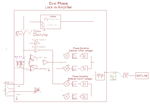David_
Advanced Member level 2
Hmm, that's was certainly some "food for thoughts".
I just found out(for the 1000nd time) that phase shift in an amplifier varies over frequency so the idea of compensating the phase shift in software doesn't appear valid, not in a system at this level anywy.
The last to posts before this one does invalidate that in other ways too, but considering what Brad and Klaus just told me I'm not particulalry happy with how my current signal chain looks. To many opamps, but I wamt to:
Adjust amplitude.
Adjust current setting resistor.
Add DC bias.
Adding switchable current setting resisotrs doesn't introduce a opamp but adjusting the amplitude and adding a DC-bias does, well the way's of doing that that I know of does. But I think we are talking about two different parts of the system.
The concept of a voltage path and a current path doesn't come into this untill after the let's call it excitation signal conditioning stage.
I updated a conseptual image of my project and have now found my self to be quite confused and don't know what I was writing about, but I'll just post the image and return later.
Regards

I just found out(for the 1000nd time) that phase shift in an amplifier varies over frequency so the idea of compensating the phase shift in software doesn't appear valid, not in a system at this level anywy.
The last to posts before this one does invalidate that in other ways too, but considering what Brad and Klaus just told me I'm not particulalry happy with how my current signal chain looks. To many opamps, but I wamt to:
Adjust amplitude.
Adjust current setting resistor.
Add DC bias.
Adding switchable current setting resisotrs doesn't introduce a opamp but adjusting the amplitude and adding a DC-bias does, well the way's of doing that that I know of does. But I think we are talking about two different parts of the system.
The concept of a voltage path and a current path doesn't come into this untill after the let's call it excitation signal conditioning stage.
I updated a conseptual image of my project and have now found my self to be quite confused and don't know what I was writing about, but I'll just post the image and return later.
Regards

